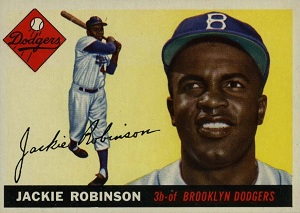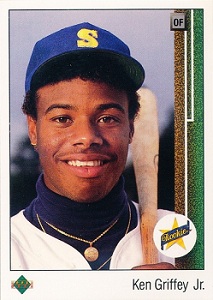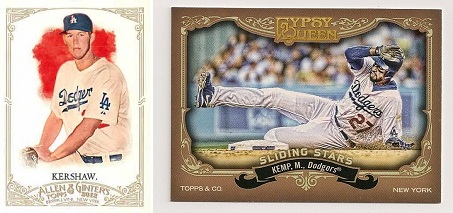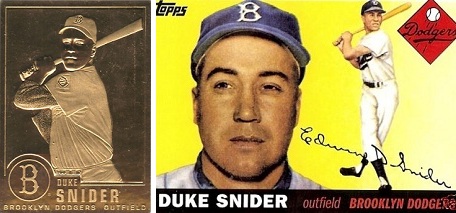I recently wrote two blog articles in which I briefly chronicled the rise of baseball cards from advertising tools – for a sporting goods company, for tobacco products and for bubble gum – to a billion dollar industry that crashed in the mid-nineties.Those looking to make big money on cards – industries and card speculators – learned a difficult lesson.
Topps is now the only company registered to produce MLB-approved cards. It seems MLB also learned that in this case, bigger isn’t better.
A pivotal moment in card history came in 1989 when Upper Deck released its first set of 800 cards complete with holograms on the back to avoid counterfeiting. This set established a new trend in high end cards and resulted in fierce competition fueling overproduction I bought the Upper Deck set in 1989 for $52.00. I can now buy it for $40. The most sought after card in that collection is a Ken Griffey Jr. rookie card.
The baseball card has taken a serious hit since the boom time from the mid-eighties to mid- nineties, but to quote Yogi Berra, “It ain’t over until it’s over.” The little piece of cardboard ( 2 1/2 by 3 1/2 inches) almost went down on a called third strike in the bottom of the ninth. The card didn’t hit a home run on that last pitch but certainly has taken the game into extra innings with the possibility of future success.
How is it that the baseball card industry has survived in the midst of a crash and two recessions? The companies have tried a number of ploys to stay afloat. One technique has been to reach back to the past and produce reprints of sets from the fifties. The 2010 Topps ‘Cards Your Mom Threw Out’ series contains 174 cards featuring baseball’s best players from the game’s modern era. This set is Topps’ interesting take on heritage cards and brings together stars like Albert Pujols with legends like Mickey Mantle. It uses an assortment of designs previously used by Topps to give the cards vintage look and feel. The set is loaded with Hall of Famers. Topps had previously issued an archived set of their 1954 cards.
Topps presently has two sets of throwback cards – Allen and Ginter and Gypsy Queen cards. Both sets recreate the cards issued by those tobacco companies during the late 1880’s. In print since 2006, the Allen and Ginter set remains one of their most popular, highest selling brands in the Topps product lineup. First printed in 2011, the Gypsy Queen set was definitely a surprise as a second vintage type set. It appears to have been successful, although in a shorter run than Allen and Ginter.
Another attempt to sustain the industry has been to release a wide variety of specialty cards, although some would argue it has been to the detriment of the industry – autographed cards, game used memorabilia cards, MLB awards cards, gold, platinum cards, cards honoring baseball legends. I have acquired eighteen 2011 and 2012 Duke Snider cards. Even the Danbury Mint got in on the act producing a 50 card set of 22kt gold cards. Their venture has not been a success while Topps has more successfully released multiple cards for individual players, especially star players. I recently purchased thirty 2012 Clayton Kershaw cards, and this is most likely not all of his 2012 cards.
Topps is doing all it can to keep the baseball portion of their business strong and growing. However, the truth of the matter is that the industry has not been rescued by itself. It has been saved only by those who purchase the product for personal pleasure, not financial gain. The lifeline is the baseball fan who not only loves the game but also the cards associated with the game. It is the collectors who treasure the cards as reflections of the game and players that play the game – those that store the cards in binders, shoe boxes, closets, and attics.
Will baseball card enthusiasts continue to acquire the cards of their choice? There is no question about it. We will be selective in what we buy, but we will buy.
The baseball card takes me back to the fifties, an age of innocence. It was a time when we played out at night until the appointed time to be home. It was a time when the doors of our homes were never locked. It was a time when we played with a baseball covered by tire tape because the cover had come off our only ball. It was a time when I listened to a Vin Scully broadcast out of Brooklyn with Dodger baseball cards beside me, holding a Duke Snider card – perhaps bending it trying to will a home run – when Duke came to the plate. That was the original “reach out and touch someone.” The baseball card industry was given life by collectors, kids back in the fifties. Baseball cards will always hold those memories, as well as many more, so we will continue to collect them.
The baseball card has provided untold hours of enjoyment for me and our son Jamie. It is a natural father-son activity, a hobby we could share as equals. We went to card shows, sought out card shops every time we had a family vacation – regardless of where it was – and went to yard sales and flea markets in search of cards. The enjoyment was not just in finding a nugget but in spending time together with a single focus, a piece of 2½ by 3½ inch cardboard. It was Jamie who pointed out to me that the Jackie Robinson card (so shiny and new looking) I found in a flea market was an original 1955 card, not a reprint card.

I purchased this 1955 Jackie Robinson card at a flea market believing it was a reprint when, in fact, it was an original.
For some time I have concentrated almost exclusively on acquiring Dodger and Dodger minor league cards. I have narrowed my search for personal as well as financial reasons, but the search does go on, especially during the winter. Living so far away from Los Angeles, and for so many years without the internet, the baseball card has kept me connected to the Dodgers. It is about as close to hands on as I can get with a piece of a Duke Snider bat, Ebbets Field seat, or Matt Kemp jersey.
Baseball card collectors still collect for the same reasons they always have. Unfortunately, the one thing Topps has not done is make the cards affordable for kids. A $2.50 pack, if one can be found, is simply too expensive for kids to even attempt to collect a full set of cards. Topps is now catering to an adult audience – those that can afford to buy the product. The challenge for Topps is to reach a new generation of collectors, the kids for whom cards seem to be naturally intended.




 January 4th, 2013 at 6:05 am
January 4th, 2013 at 6:05 am  by Harold Uhlman
by Harold Uhlman 


 Posted in
Posted in 

Great article!! I am not a card collector so knew very little about their history. I appreciate the education.
Harold, I used to be an avid collector for about 10 years (1990 to 2000)until I got turned off be the overproduction and the flooding of the market. So, I’m a little out of touch with what has gone on since then. Is Topps the only company that’s producing baseball cards now? Upper Deck, Fleer, and Donruss, are they all out of business?
I also remember the 1989 Upper Deck Ken Griffey Jr. rookie card being a hot item when it first came out. How has the value of that card fared over the years? I know I have one and I think I paid $35.00 for it in the early ’90s.
I agree with what you said about it not being affordable for kids now a days. I remember when I was a kid the Topps cards were 5 cents a pack. My father would give me 50 cents and I would run to the candy store and buy 10 packs. What a thrill it was opening so many packs at once and lookind for Koufax, Drysdale, and other Dodgers. When I was done I would have a stack of 50 cards. Those were great days, who would think a piece of 2½ by 3½ inch cardboard could make a kid so happy.
I really enjoy your articles on baseball card collecting. Keep them coming.
Will, Topps is the only company sanctioned by MLB to produce baseball cards using pictures of players in team uniforms and using team logos.
Panini has a deal with the MLBPA to produce cards but cannot use team uniforms or logos. Panini cards therefore must have pictures where the team name doesn’t show and the hats are blank. I don’t really care for those cards.
Great article Harold. I try just focus on buying Heritage every year, ilike the way the Allen Ginter and Gypsy Queen look, and might buy some of those this year.
I have no kids and have tried to get my sisters kids involved in baseball cards, but kids these days don’t seem to get ass excited as I did as a kid.
“…but kids these days don’t seem to get ass excited as I did as a kid.”

I have never taken a liking to the Ginter cards. I prefer a photo of the player as opposed to a drawing of them – although the drawings are incredibly detailed.
The real excitement for me as a kid Evan was that we had no TV until the mid fifties. The baseball card introduced us to the players we were hearing about on the radio. We got to see them. I learned that Jackie, Campy, Newk, Jim Gilliam and Joe Black were black through baseball cards. Also players like Luke Easter, Monte Irvin and yes Willie Mays.
We had no distractions like video games and other electronic devices. That makes if difficult for a card to compete for a kid’s attention.
I think the only way kids are going to get involved these days is for it to be like Harold and Jamie, a father / son type of experience.